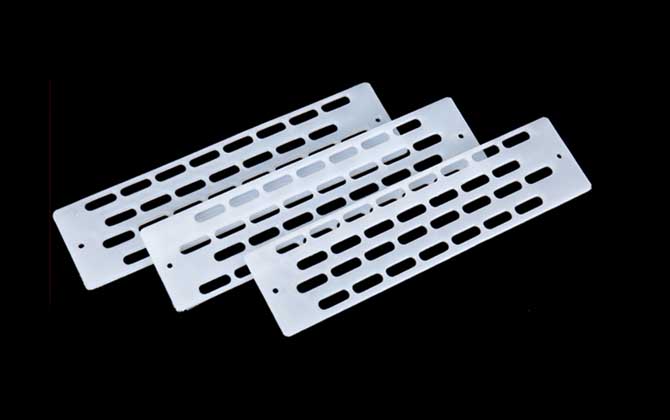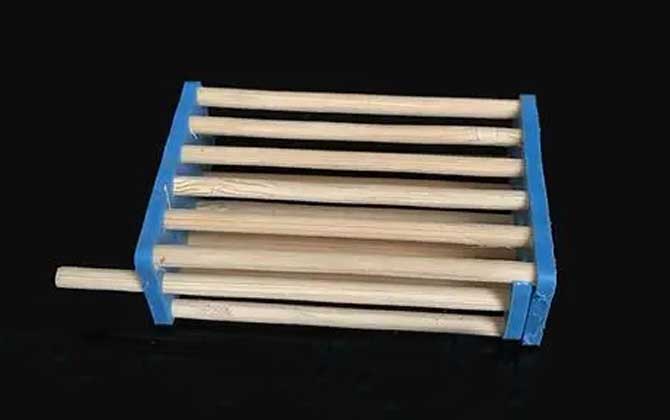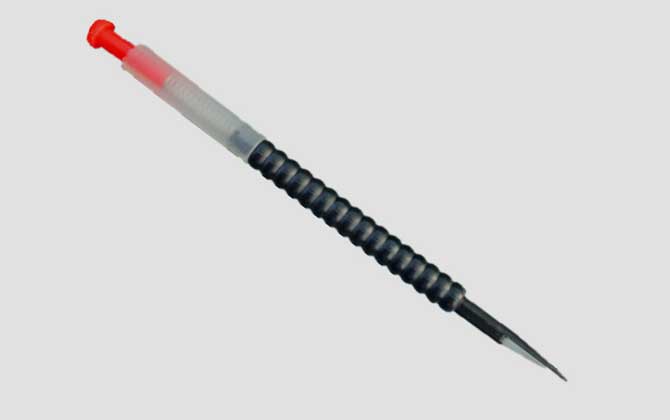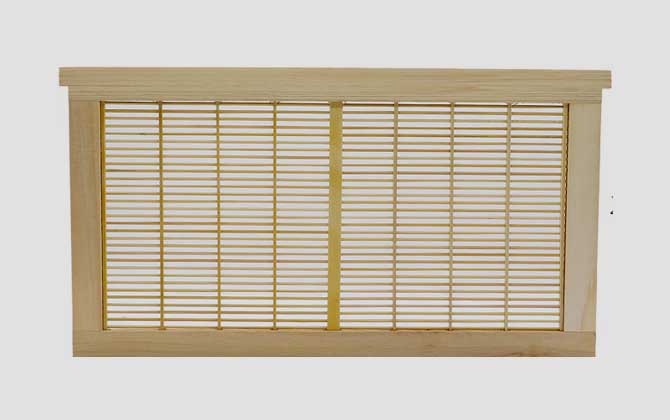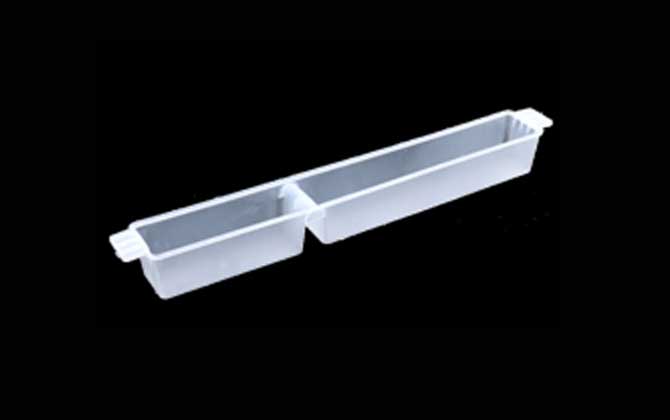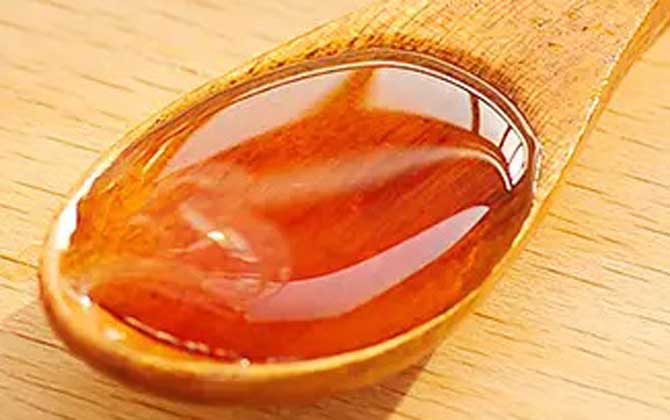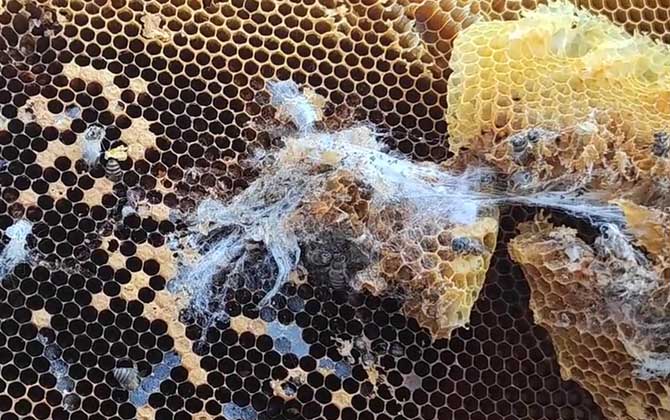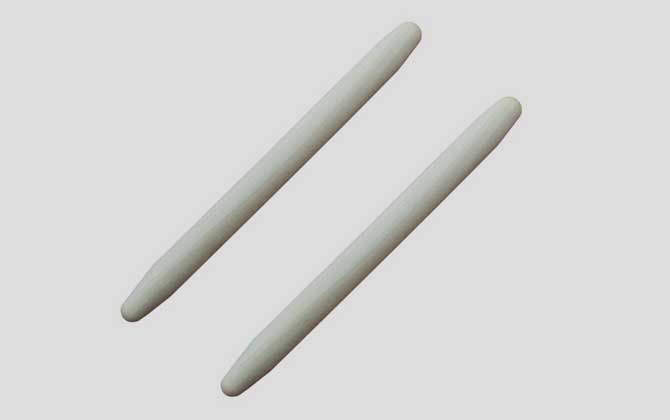Queen Bee Escape Guards:Durable Plastic & Bamboo Hive Entrance Tools for Beekeeping in China
2025-04-17
Queen Excluder: Essential Beekeeping Tool for Colony Management Definition and Purpose A queen excluder (also called bee escape guard) is a specialized beekeeping device primarily designed to prevent queen bees from leaving the hive while allowing worker bees free passage. Typically constructed from bamboo slats or durable plastic sheets, this tool is installed at the hive entrance. Its strategic design ensures colony stability, particularly crucial for newly captured swarms that might otherwise abandon their new habitat. Design Principles The excluder operates on precise biological measurements: Thorax differential: Queen bees have 20-30% thicker thoraxes than workers (4.8-5.2mm vs 3.8-4.2mm) Slot calibration: Gap width set between 4.3-4.7mm Material durability: UV-resistant plastics or weather-treated bamboo This engineered spacing allows worker bees unrestricted movement while physically restraining queens. Key Functions Beyond basic containment, queen excluders serve multiple roles: Swarm prevention: Reduces colony loss by 85% during establishment phase Queen management: Enables controlled mating flights when temporarily removed Disease control: Limits pathogen spread through restricted queen movement Hive organization: Facilitates better brood chamber management Operational Guidelines Proper usage requires attention to: Installation timing: Apply during peak foraging hours (10AM-2PM) Duration limits: Maximum 21-day continuous use to prevent drone entrapment Maintenance: Weekly cleaning to remove propolis buildup Monitoring: Regular checks for worker bee abrasion marks Note: 68% of beekeepers report increased colony stability when following these protocols. Application Scenarios 1. New Colonies Essential for 2-3 weeks post-capture. Remove when: – 80% comb construction completed – Regular pollen patty deposits observed – Queen laying pattern established 2. Migratory Beekeeping Use during transportation (max 72 hours): – Prevents absconding during relocation – Reduces stress-induced swarming by 40% – Combine with ventilation screens for optimal results 3. Swarm Control Temporary installation when: – 35%+ population increase observed – Queen cell development detected – Nectar flow decreases below 1kg/day Advanced…
Queen Bee Cage:Essential Beekeeping Tool for Safe Hive Management and Queen Introduction
2025-04-14
Queen Cage: Essential Tool in Beekeeping I. Definition and Overview The queen cage is a specialized beekeeping tool designed to temporarily confine queen bees. Typically constructed from bamboo, wood, or plastic, this device features precisely calibrated gaps between its bars. These gaps are strategically sized between the thoracic thickness of queen bees and worker bees, allowing worker bees free access while securely containing the queen. Its primary applications include new queen introduction and controlled egg-laying management. II. Design Principles The cage’s effectiveness stems from distinct biological differences: Thoracic measurements: Queen bees (1.8-2.0mm) vs Worker bees (1.4-1.6mm) Bar spacing: 1.6-1.8mm (prevents queen escape) Material durability: Weather-resistant plastics or untreated hardwoods This precision engineering enables continuous colony interaction while maintaining queen containment. III. Primary Functions Queen cages serve multiple critical roles: Safe queen introduction to new colonies Egg-laying regulation during honey flows Temporary queen isolation during disease treatment Queen banking for commercial operations Emergency queen protection during colony disturbances IV. Proper Usage Guidelines For optimal results: Position cage on honeycomb with direct worker access Ensure adequate ventilation and feeding ports Limit confinement period (typically 3-7 days) Monitor worker interaction patterns Use smooth plastic cages to prevent leg damage Critical Note: Always handle queens gently using specialized tools to prevent abdominal injury. V. Practical Applications 1. Queen Introduction: Gradual scent integration over 24-72 hours Reduces worker rejection from 40% to <5% Enables controlled pheromone transfer 2. Egg-Laying Management: Increases honey production by 20-30% during flows Prevents brood competition during nectar dearth Facilitates colony population control 3. Queen Banking: Maintains backup queens with host colonies Allows emergency replacement within 24 hours Supports commercial pollination operations VI. Maintenance Considerations Proper care ensures longevity: Regularly clean with propolis solvent Inspect bar spacing monthly Disinfect between uses (5% acetic acid solution) Store in dry, pest-free environments Modern…
Professional Bee Grafting Needle for Efficient Queen Rearing and Royal Jelly Production
2025-04-13
The Larval Transfer Needle: A Beekeeper’s Essential Tool Definition and Overview The larval transfer needle is a specialized beekeeping tool primarily composed of three key components: a buffalo horn blade, plastic tube, and pusher rod. This precision instrument enables beekeepers to transfer worker bee larvae into artificial queen cells. Its dual-purpose application spans both queen rearing and royal jelly production – two fundamental processes in modern apiculture. Design Principles Engineered for delicate operations, the tool’s design features: Buffalo Horn Blade: Combines rigidity with flexibility, enabling smooth insertion along comb walls Plastic Tube: Provides structural support and guidance Pusher Rod: Facilitates controlled larval placement The horn blade’s unique properties allow it to: Withstand repeated flexing without deformation Slide beneath larvae without damage Lift larvae with their nutrient-rich royal jelly intact Key Applications This indispensable tool serves two primary functions in commercial beekeeping: Application Process Outcome Queen Rearing Transferring larvae to queen cells Controlled queen production Royal Jelly Production Mass larval transplantation High-yield royal jelly harvest Operational Techniques Queen Rearing Protocol Create artificial queen cells using wax and a cell-building frame Gently slide horn blade under 12-24 hour old larvae Transfer larvae with attached royal jelly to new cells Introduce prepared cells to queenless colony Royal Jelly Harvesting Method Prepare multiple artificial queen cells Transfer larvae using same technique as queen rearing Harvest royal jelly 72 hours post-transplantation Reuse cells after careful cleaning Tool Variations Modern apiculture offers multiple needle types: Buffalo Horn: Industry standard (60-80% market share) Stainless Steel: Durable but higher larval mortality Goat Horn: Premium alternative (15-20% more costly) Goose Quill: Traditional Chinese design Spring-Loaded: 1960s innovation for rapid transfers Maintenance Tips Proper care ensures optimal performance: Clean with warm water (<40°C) after each use Disinfect weekly with 70% ethanol solution Store in dry environment to prevent horn warping…
Ultimate Guide to Beehive Queen Excluders:Types,Materials,and Installation Tips for Effective Honey Bee Management
2025-04-10
Queen Excluder: Essential Beekeeping Tool I. Definition and Overview A queen excluder is a specialized beekeeping tool designed to restrict the movement of queen bees while allowing worker bees free passage. Typically constructed from bamboo, wood, or plastic, it comes in two primary forms: flat excluders and frame-style excluders (vertical excluders). The key feature is its precisely spaced grid (4.0-4.2mm), which is calibrated between the thoracic thickness of queen bees (4.8-5.2mm) and worker bees (3.8-4.0mm). This design ensures queens remain confined to specific hive sections without disrupting colony activities. II. Design Principles Biometric Precision: Utilizes the 15-20% greater thoracic depth of queen bees compared to workers Material Engineering: Durable food-grade plastics or weather-resistant wood ensure longevity Modular Construction: Interchangeable components adapt to different hive configurations This scientific approach allows 98% worker bee mobility while maintaining 100% queen restriction in standard Langstroth hives. III. Key Functions Queen Containment: Prevents territorial conflicts in multi-queen systems Brood Control: Limits egg-laying to designated comb areas Honey Management: Facilitates pure comb honey production in supers Swarm Prevention: Reduces swarming impulses through controlled expansion IV. Classification System Type Installation Best Use Flat Excluder Between brood chamber and honey super Commercial honey production Frame Excluder Within brood chamber Nucleus colony management By Bee Species: Apis cerana Excluders: 3.9-4.1mm spacing Apis mellifera Excluders: 4.2-4.4mm spacing V. Practical Applications Dual-Queen Systems: Maintains 2 productive queens with 87% reduced conflict risk Comb Honey Production: Achieves 95% wax purity in supers Selective Breeding: Isolate specific genetic lines with 99% accuracy Disease Management: Contains infected brood areas during AFB outbreaks VI. Maintenance Guidelines Clean monthly with 5% acetic acid solution Inspect grid alignment every 2 weeks during peak season Replace plastic components every 3-5 seasons Pro Tip: Apply beeswax lubricant to excluder edges during installation to improve worker bee acceptance by 40%.
Top Bee Feeders for Beekeeping:High-Efficiency Hive,Entrance & Internal Feeders for Sugar Syrup & Dry Sugar
2025-04-10
Bee Feeders: Essential Tools for Beekeeping A bee feeder is a specialized tool in apiculture designed to hold feed or water for honeybee colonies. These devices vary in design based on feed type and placement, playing a critical role in maintaining colony health and productivity. 1. Definition and Purpose Bee feeders serve as containers for nutritional supplements and water. They are categorized into two primary types: Sugar syrup feeders: Used for liquid nutrition (can double as water dispensers) Dry sugar feeders: Designed for crystalline sugar distribution Practical applications include supplementing food during nectar shortages and providing water in arid conditions. Modern feeders often feature anti-drowning mechanisms and are made from food-grade plastics for bee safety. 2. Classification by Placement 2.1 Sugar Syrup Feeders Entrance feeders (e.g., Boardman feeders) – Mounted at hive entrance Internal frame feeders – Fit between honey frames Top feeders – Placed above brood boxes Bottom feeders – Positioned under the hive body 2.2 Dry Sugar Feeders Shallow tray design matching hive dimensions 30mm height with central access points Typically placed between hive body and inner cover 3. Feeding Strategies Supplemental Feeding Ensures colony survival during shortages Critical pre-winter preparation Uses thick 2:1 sugar syrup Stimulative Feeding Encourages brood production Uses thin 1:1 sugar syrup Essential for spring/fall expansion Calming Feeding Stabilizes colonies after disturbances Used during hive transfers or requeening Often incorporates aromatic herbs 4. Operational Guidelines Feed Type Equipment Preparation Best Practices Sugar Syrup Liquid feeders Boil water, dissolve sugar (1:1 or 2:1 ratio) Cool to room temperature before use Dry Sugar Tray feeders Use refined white sugar Place above cluster in cool weather Water Specialized waterers Add floatation devices to prevent drowning Maintain continuous supply in summer Pro Tips: Always clean feeders between uses to prevent mold growth. Monitor consumption rates – normal intake…
Honey Extractor Machine:Essential Beekeeping Tool for Efficient & High-Quality Honey Production in China
2025-04-09
What is a Honey Extractor? The honey extractor is a specialized tool in beekeeping designed to separate honey from honeycombs. Recognized as one of the “Three Major Apicultural Inventions” alongside movable-frame hives and comb foundation machines, modern extractors significantly improve honey harvesting efficiency while preserving honey quality. This equipment has become indispensable in commercial apiaries worldwide. Definition and Key Features A honey extractor operates through centrifugal force to remove honey from uncapped frames without destroying the wax structure. Modern models primarily use food-grade plastic or stainless steel, though some beekeepers create DIY wooden versions for small-scale operations. Key characteristics include: Non-destructive honey extraction Reusable comb frames Adaptable to different frame sizes Working Principle The extraction process relies on precise centrifugal force physics: Frames rotate at controlled speeds (typically 200-300 RPM) Honey droplets experience centrifugal acceleration (Fc = mω²r) Centrifugal force exceeds comb adhesion forces (5-10 N/m²) Honey separates radially into collection tanks Modern models feature variable speed controls to accommodate different honey viscosity levels. Types of Honey Extractors Beekeepers can choose from various configurations: By Power Source Manual Extractors: Cost-effective for small apiaries (1-20 hives) Electric Extractors: Essential for commercial operations (50+ hives) By Capacity 2-Frame: Most common for hobbyists 4-8 Frame: Semi-professional use 20+ Frame: Industrial-scale operations By Construction Material Stainless Steel: Durable & hygienic Food-Grade Plastic: Lightweight & corrosion-resistant Galvanized Steel: Budget option (requires regular maintenance) By Frame Orientation Tangential: Requires frame flipping Radial: Automatic dual-side extraction Autoreverse: Computer-controlled rotation Step-by-Step Operation Guide Preparation Disassemble and sanitize all components Inspect gaskets and bearings Ensure proper drainage alignment Frame Loading Uncap cells using heated knives (45-50°C) Balance frame weights symmetrically Secure frame baskets properly Extraction Process Start rotation at low speed (≤100 RPM) Gradually increase to operational speed Monitor honey flow through inspection windows Honey Collection Filter through 200-400…
Premium Chinese Codonopsis Honey:Raw Amber Non-Crystallized Natural Sweetener from Northern China Regions
2025-04-08
Dangshen Honey: A Premium Monofloral Honey Overview Dangshen honey is produced by bees collecting nectar from Codonopsis pilosula (a perennial herb of the Campanulaceae family), primarily cultivated in North China, Northwest China, and Northeast China. In its liquid state, it appears as a viscous, semi-transparent amber-colored substance with a natural luster. While resistant to crystallization, prolonged exposure to low temperatures (below 14°C) may cause it to form pale-yellow coarse granules. 1. Nectar Source Characteristics Botanical Profile: – Family: Campanulaceae – Genus: Codonopsis – Flowering Period: July to September – Optimal Nectar Secretion Temperature: 20-28°C The nectar flow period lasts approximately 40-50 days, with reduced production when temperatures exceed 30°C or drop below 15°C. A single bee colony (typically Apis mellifera) can produce 60-80 jin (30-40 kg) per flowering season, reaching over 100 jin (50 kg) in peak conditions. 2. Physical Properties Appearance: Viscous amber liquid with semi-transparent clarity Aroma: Distinctive floral scent of dangshen blossoms Flavor Profile: Sweet with subtle acidity and lingering aftertaste Crystallization: Slow crystallization process forming pale-yellow granular texture 3. Geographical Distribution Major production areas include: – Northern China: Hebei, Shanxi, Inner Mongolia – Northwestern China: Shaanxi, Gansu, Qinghai – Northeastern China: Liaoning, Jilin – Secondary regions: Western Sichuan, Northern Yunnan, and Southeastern Tibet Note: Over 95% of commercial dangshen honey originates from cultivated plantations, as wild Codonopsis pilosula rarely forms sufficient nectar for large-scale collection. 4. Nutritional Composition Component Percentage Health Benefit Fructose 40.70% Rapid energy source, fatigue reduction Glucose 33.90% Immediate metabolic fuel Sucrose 4.30% – Iron 0.85mg/100g Hemoglobin synthesis Additional bioactive components include amylase, catalase, and phenolic compounds with antioxidant properties. 5. Health Benefits & Applications Immune Enhancement – Monosaccharides stimulate lymphocyte proliferation – Zinc and selenium boost leukocyte activity Digestive Support – Organic acids (gluconic, citric) improve gut microbiota – Enzymes enhance protein…
Greater Wax Moth (Galleria mellonella):Impacts on Chinese Beekeeping and Honey Production from Hive Infestations
2025-04-08
Greater Wax Moth: A Major Threat to Honeybees The Greater Wax Moth (Galleria mellonella), also known as waxworm, honeycomb moth, or bee moth, is a destructive pest in apiculture. Classified under the family Pyralidae and genus Galleria, its larvae primarily infest honeybee colonies by consuming beeswax comb structures. This pest poses significant risks to beekeeping operations, ranging from reduced honey yield and quality to complete colony collapse in severe infestations. I. Biological Classification Kingdom Animalia Phylum Arthropoda Class Insecta Order Lepidoptera Family Pyralidae Genus Galleria Species G. mellonella Aliases Wax Moth, Hive Worm (larva), Cotton Worm (larva), Wax Worm This cosmopolitan pest demonstrates remarkable adaptability, with its larvae capable of digesting beeswax – a trait rare among insects. The metabolic process involves specific gut enzymes that break down complex wax components into usable nutrients. II. Morphological Characteristics Eggs: Oval-shaped, 0.3-0.4 mm long, with color progression from pink to yellowish-brown Larvae: Cream-colored upon hatching, developing grey dorsal stripes at maturity (up to 28 mm length) Pupae: 12-20 mm long, encased in silken cocoons Adults: Silver-grey moths with 30-41 mm wingspan, exhibiting sexual dimorphism (females larger) Adult moths possess specialized scent receptors to locate bee colonies, while larvae show distinctive mandibular adaptations for wax consumption. III. Global Distribution While prevalent in tropical and subtropical regions (25-35° latitude), this species demonstrates remarkable thermal tolerance: Optimal range: 28-35°C Survival limits: -6.5°C to 45°C Major Chinese habitats: Guangdong, Yunnan, Hainan, Taiwan Global spread: Reported in 68 countries across six continents IV. Life Cycle and Behavior Developmental Stages: Stage Duration Temperature Sensitivity Egg 8-23 days Requires >60% humidity Larva 27-48 days Optimal: 30-35°C Pupa 9-23 days Metamorphosis inhibitor below 15°C Adult 9-44 days Flight activity >18°C Key Behavioral Patterns: Nocturnal mating (peak activity 20:00-23:00) Oviposition preference for dark crevices (200-600 eggs/female) Larval photophobic behavior Pupation in…
Queen Rearing Stick:Essential Beekeeping Tool Guide for Creating Artificial Queen Cells in Chinese Apiculture
2025-04-02
The Queen Rearing Stick: A Comprehensive Guide for Beekeepers Definition and Overview The queen rearing stick is a specialized tool in apiculture, traditionally crafted from dense, durable hardwoods like beech or maple. This essential implement serves to mold melted beeswax into artificial queen cells (known as “artificial queen cups”), which form the foundation for controlled queen breeding programs. Variations exist to accommodate different honeybee subspecies: Chinese honeybee (Apis cerana) sticks, Western honeybee (Apis mellifera) sticks, and dual-purpose models featuring different-sized ends for both species. Key Functions While not as frequently used as foundation sheets or queen excluders, the queen rearing stick plays crucial roles in: Creating standardized artificial queen cells Facilitating controlled queen rearing programs Maintaining genetic lines through selective breeding Enabling emergency queen replacement in colonies Modern alternatives include pre-formed plastic queen cups, but traditional wax modeling remains preferred for its natural acceptance by colonies. Critical specification differences exist between sticks for different subspecies – Apis cerana tools (6-8mm diameter) cannot substitute Apis mellifera models (8-10mm). Design Principles This precision tool replicates the exact dimensions of natural queen cells through: Biomimetic engineering based on wild colony measurements Conical shaping from rounded tip to handle (6-10mm diameter range) Surface texturing mimicking natural wax deposition patterns The design process involves detailed study of natural emergency queen cells, which worker bees build vertically with distinct size progression from base to opening. Technical Specifications by Subspecies Type Base Diameter Mid-Point Diameter Application Apis cerana Stick 6mm 8mm Asian honeybee colonies Apis mellifera Stick 8mm 10mm European honeybee colonies Dual-Purpose Model 6mm/8mm 8mm/10mm Mixed apiary operations Step-by-Step Usage Guide 1. Wax Preparation Use pure beeswax melted at 62-65°C (143-149°F) for optimal plasticity. Pro tip: Add 5% propolis for improved cell acceptance rate. 2. Molding Process Pre-cool stick in water (15-18°C) Dip vertically into molten…
